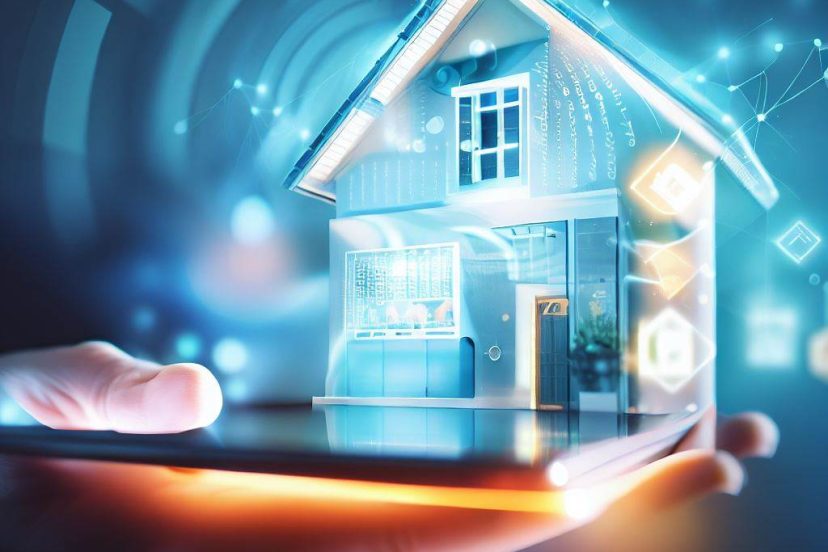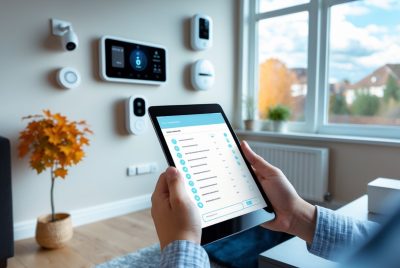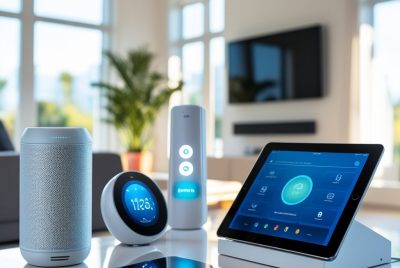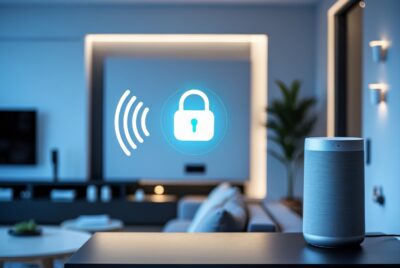Smart Home Design: The Future of Living
*We may earn a commission for purchases made using our links. Please see our disclosure to learn more.
Smart Home Design: Essential Tips for a Modern Living Space
Creating a smart home design can transform the way you live, adding convenience, security, and efficiency to your daily routines. A smart home integrates devices like smart bulbs, thermostats, security cameras, and voice assistants to automate and control your home environment effortlessly. Imagine controlling your lights, locks, and even your air conditioner with just a voice command or a few taps on your smartphone.

When designing a smart home, it’s essential to set clear goals and a budget to avoid unnecessary expenses. Start by identifying the areas where smart technology can bring the most benefit, like improving home security or reducing energy consumption. Choose devices that are compatible with each other to ensure seamless integration and control.
Automation can simplify your life by scheduling routine tasks, such as adjusting the thermostat when you leave for work or setting the lights to turn off automatically at bedtime. With the right approach and devices, you can tailor a smart home that perfectly suits your preferences and lifestyle.
Fundamentals of Smart Home Design

Smart home design centers on integrating technology to enhance comfort, security, and efficiency. In this section, I’ll explore what makes a home “smart”, essential technologies, and user-focused principles.
Defining Smart Homes
A smart home uses internet-connected devices to control and automate systems such as lighting, heating, and security. This integration aims to make everyday tasks more convenient and efficient. For example, you can control the thermostat using your smartphone or set up routines where lights turn off when no one is home.
Smart homes also enhance security by allowing remote monitoring through cameras and motion detectors. They provide energy savings by optimizing consumption based on user habits. These features contribute to a holistic improvement in daily living.
Essential Smart Home Technologies
Several technologies form the backbone of a smart home. Wi-Fi networks ensure devices can communicate with each other. A robust Wi-Fi setup is crucial for a seamless experience. Smart speakers like Google Nest or Amazon Echo act as a hub for voice commands, controlling lights, locks, and other devices.
Smart lighting systems allow for customizability in brightness and color, often controlled remotely. Thermostats like the Nest Learning Thermostat can save energy by adapting to your schedule. Security systems featuring smart locks, cameras, and motion sensors offer peace of mind. These technologies make up the core components of a smart home.
User-Centric Design Principles
User-centric design is about making the technology serve the people using it. First, the system should be intuitive. Anyone should be able to control it without needing a manual. Customization is another key. Users should customize settings to fit their routines and preferences easily.
Reliability is also crucial. Devices must work consistently without frequent malfunctions. Security should not be compromised, ensuring that user data is protected against breaches. Finally, the design should promote energy efficiency to reduce environmental impact and save on utility bills.
These principles ensure smart home technology is both useful and user-friendly.
Planning and Implementing Smart Home Infrastructure

Designing a smart home involves more than just picking gadgets; it requires thoughtful planning of wiring, energy management, and future-proofing to ensure a seamless experience.
Wiring and Connectivity Considerations
One of the first steps in creating a smart home is ensuring proper wiring and connectivity. Structured wiring is essential. This means using high-quality cables like Cat6 or fiber optics for faster data transfer and more reliable connections.
Wi-Fi coverage must be strong throughout the home. Installing wired access points can help achieve this. It’s also important to consider network security. A secure network ensures that your data and devices are safe from cyber threats.
Planning for future connectivity needs is crucial. Installing extra conduit or wiring now can save time and money later.
Energy Efficiency and Management
Incorporating energy-efficient systems helps make the smart home more sustainable. Smart thermostats can adjust heating and cooling based on your habits, reducing energy consumption. Energy-efficient appliances use less power and can often be controlled remotely.
Smart lighting systems allow you to control lights via smartphone apps or voice commands, and they can be set to turn off when a room is unoccupied. By integrating solar panels with battery storage, you can reduce reliance on the grid and minimize long-term electricity costs.
Future-Proofing Your Smart Home
Future-proofing ensures your smart home remains functional as technology evolves. I recommend installing universal standards for devices, such as Zigbee or Z-Wave. This makes it easier to add new devices later.
Always consider scalability. Plan for additional devices and upgrades without needing major rewiring. Software updates should be easy to manage, ensuring that security patches and new features can be easily applied.
Lastly, modular designs in your smart home infrastructure allow easy replacements and upgrades, extending the life and functionality of your home.
Selecting Smart Devices and Ecosystems

When setting up a smart home, choosing the right devices and ecosystem is crucial. It’s necessary to consider compatibility, ease of use, and security.
Smart Home Hubs and Controllers
Smart home hubs act as the brain of your setup. They connect and control different devices from one central point. Popular choices include Amazon Alexa, Google Home, and Apple HomeKit.
These hubs support a wide range of devices like smart lights, thermostats, and security cameras. Some hubs offer voice control, while others use dedicated apps on smartphones or tablets.
I prefer hubs that offer comprehensive integration, allowing seamless control and automation of various smart gadgets. This makes managing your smart home straightforward.
Choosing Compatible Devices
Compatibility is essential for smooth operation. Make sure your chosen devices work with your selected hub or controller. If you’re using Amazon Alexa, opt for devices labeled “Works with Alexa.”
Compatibility ensures that devices can communicate effectively. I often create a list of needed gadgets, then check their compatibility before purchasing. This includes smart bulbs, plugs, sensors, and cameras.
Manufacturers usually provide detailed compatibility lists on their websites. Refer to these lists to avoid any issues. Investing time in this step saves you from future headaches.
Security and Privacy Implications
Security and privacy should not be overlooked when choosing smart devices. Many gadgets collect data, so it’s important to know how this data is used and stored.
I recommend using devices with strong encryption and regular security updates. It’s wise to research each brand’s privacy policies. Ensuring your home network is secure adds an extra layer of protection.
Further, always change default passwords on smart devices and use two-factor authentication where possible. Staying informed about potential vulnerabilities helps keep your smart home safe.
Design Aesthetics and User Experience

In smart home design, aesthetics and user experience are closely linked. Creating a seamless blend between technology and everyday living spaces is essential for both visual appeal and ease of use.
Integrating Technology Seamlessly
A big part of smart home design is making sure the technology fits naturally into the home rather than standing out. This can be achieved by using minimalist design options where devices are hidden or built into existing furniture and walls.
For instance, voice-activated controls like Amazon Alexa or Google Assistant can be integrated into light fixtures or kitchen appliances. This helps keep the tech inconspicuous while still maintaining functionality.
Low-profile designs are another way to achieve seamless integration. Wall-mounted tablets, in-wall speakers, and sleek thermostats contribute to a clutter-free look. The goal is to avoid unnecessary elaboration, ensuring that technology enhances rather than disrupts the aesthetic.
User Interface Design
Effective UI design is crucial for making smart home tech easy and enjoyable to use. User-friendly interfaces should be intuitive, with clearly labeled buttons and responsive feedback. This makes everyday tasks simple, like adjusting the temperature or setting up routines.
Icons and color schemes play an important role. Consistent icons and user-friendly color palettes make navigation more straightforward. Bright colors can signify important alerts, while muted tones can offer a calming effect.
Clear and concise menus reduce the user’s cognitive load. For example, grouping similar settings together can save time and effort. Personalization is also key; allowing users to customize their interface can improve satisfaction and usability, making the smart home feel truly their own.
Smart Home Automation and Control Systems

Smart home automation and control systems have become vital for modern living. These systems enhance comfort, convenience, and energy efficiency through streamlined management of lighting, climate, and entertainment.
Automated Lighting and Shades
Automated lighting systems use smart bulbs, switches, and sensors to manage the lighting in a home. I can schedule lights to turn on or off at specific times or control them remotely through my smartphone. This not only adds convenience but also improves home security by making it look like someone is home when I’m away.
Shades can also be automated to open and close based on the time of day or sunlight intensity. This is especially useful for reducing energy costs. For example, shades can close during the hottest part of the day to keep the house cool, reducing the need for air conditioning.
Climate Control and Energy Savings
Smart thermostats are a key component in climate control. I can set these devices to learn my preferences over time, adjusting the temperature automatically to save energy. They can also be controlled remotely, allowing me to change the settings even when I’m not home.
Energy savings go beyond just the thermostat. Smart plugs and appliances can monitor and manage power usage. For instance, I can schedule my washing machine to run during off-peak hours to save on electricity bills. Using these devices, I can keep my home comfortable while also being mindful of energy consumption.
Multimedia and Entertainment Systems
Incorporating multimedia and entertainment systems into a smart home can significantly enhance my living experience. Smart TVs, speakers, and streaming devices can be connected and controlled through a central hub or voice assistant like Amazon Alexa or Google Assistant.
I can create a seamless entertainment experience by integrating these systems with lighting and shades. For instance, I can set a “movie mode” that dims the lights and closes the shades while turning on my desired movie on the TV. This kind of automation enriches leisure time and makes managing multiple devices straightforward and enjoyable.
Using these automation and control systems, a smart home becomes not just a place to live, but a personalized, efficient, and engaging environment.
Frequently Asked Questions
Designing a smart home can be seamless and efficient with the right focus and resources. Key considerations include essential elements, cost-effective strategies, current trends, energy efficiency, recommended software, and available professional courses.
1. What are the essential elements to consider when designing a smart home?
When designing a smart home, I always look at integration and compatibility. Systems like lighting, heating, security, and entertainment need to communicate effectively. Also, focus on ease of use, such as voice control or smartphone access, for a seamless experience.
2. What are the cost-effective strategies for converting an existing home into a smart home?
For a budget-friendly conversion, prioritize essential upgrades first. Start with smart lighting and thermostats, which can provide immediate benefits. Wireless systems are often more cost-effective and easier to install in existing homes compared to hardwiring.
3. What are the latest trends in smart home design?
Current trends include voice-activated assistants, energy-efficient appliances, and advanced security systems. Many homeowners are also incorporating renewable energy sources like solar panels. Staying updated with these trends ensures your smart home remains cutting-edge and efficient.
4. How can smart home design enhance energy efficiency?
Smart home systems can significantly improve energy use. Smart thermostats adjust heating and cooling based on occupancy, and smart lighting systems turn off when rooms are unused. Integrating energy monitoring provides insights that help reduce overall consumption.
5. What software is recommended for designing a smart home layout?
Software like Home Designer Suite, Google SketchUp, and AutoCAD provide excellent tools for planning a smart home layout. These programs allow me to visualize and test different configurations before implementing them, ensuring optimal design and functionality.




